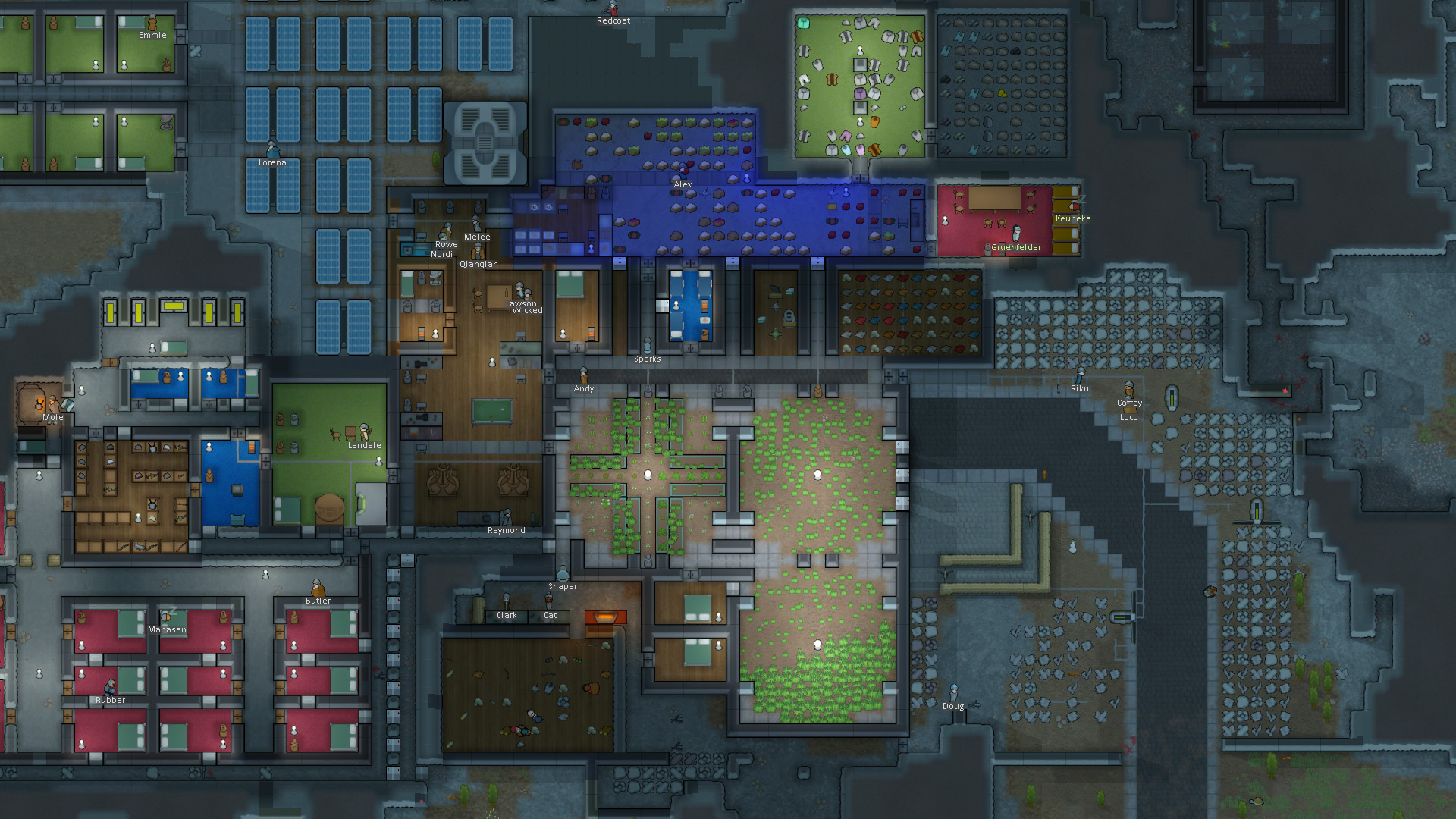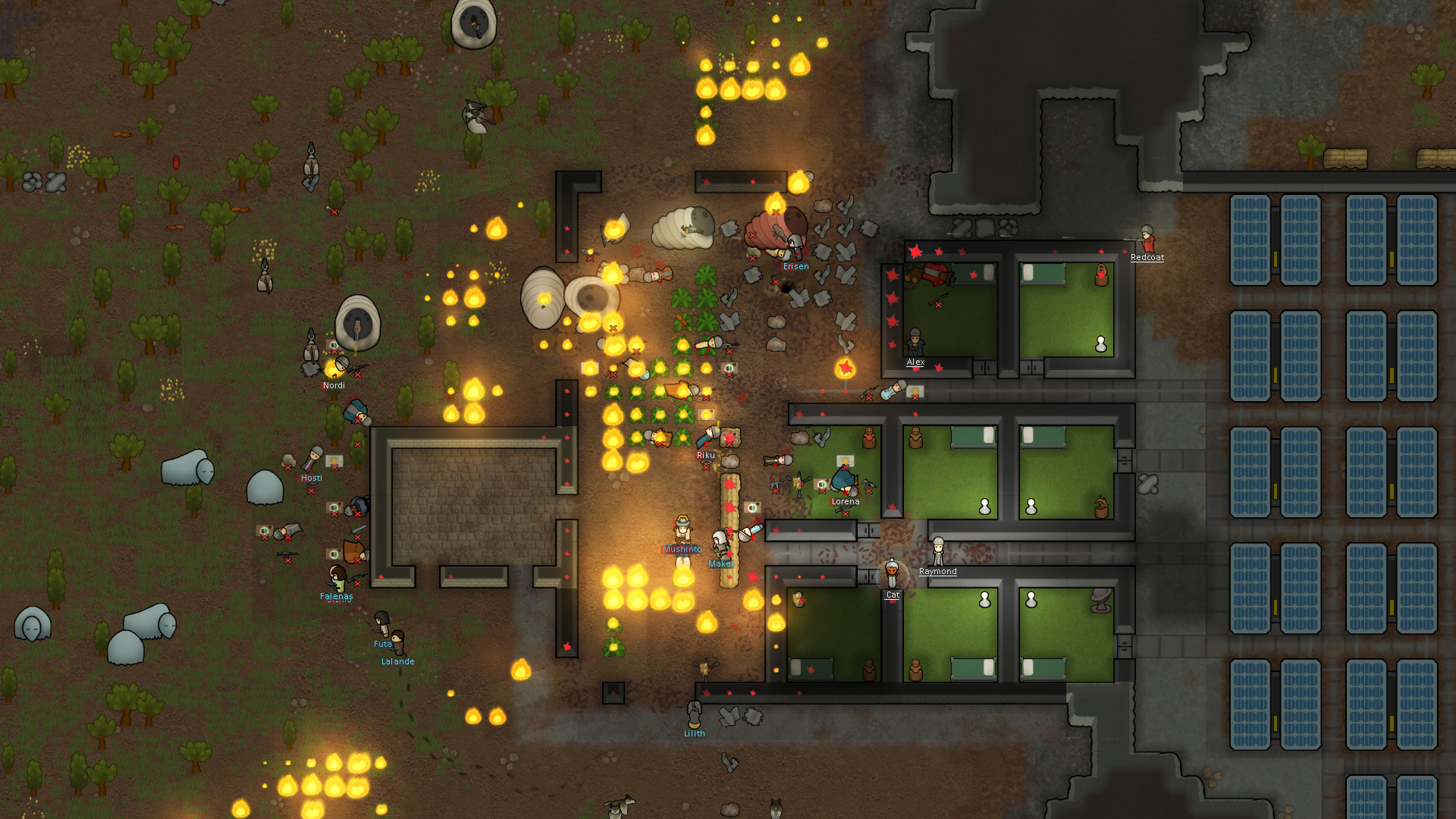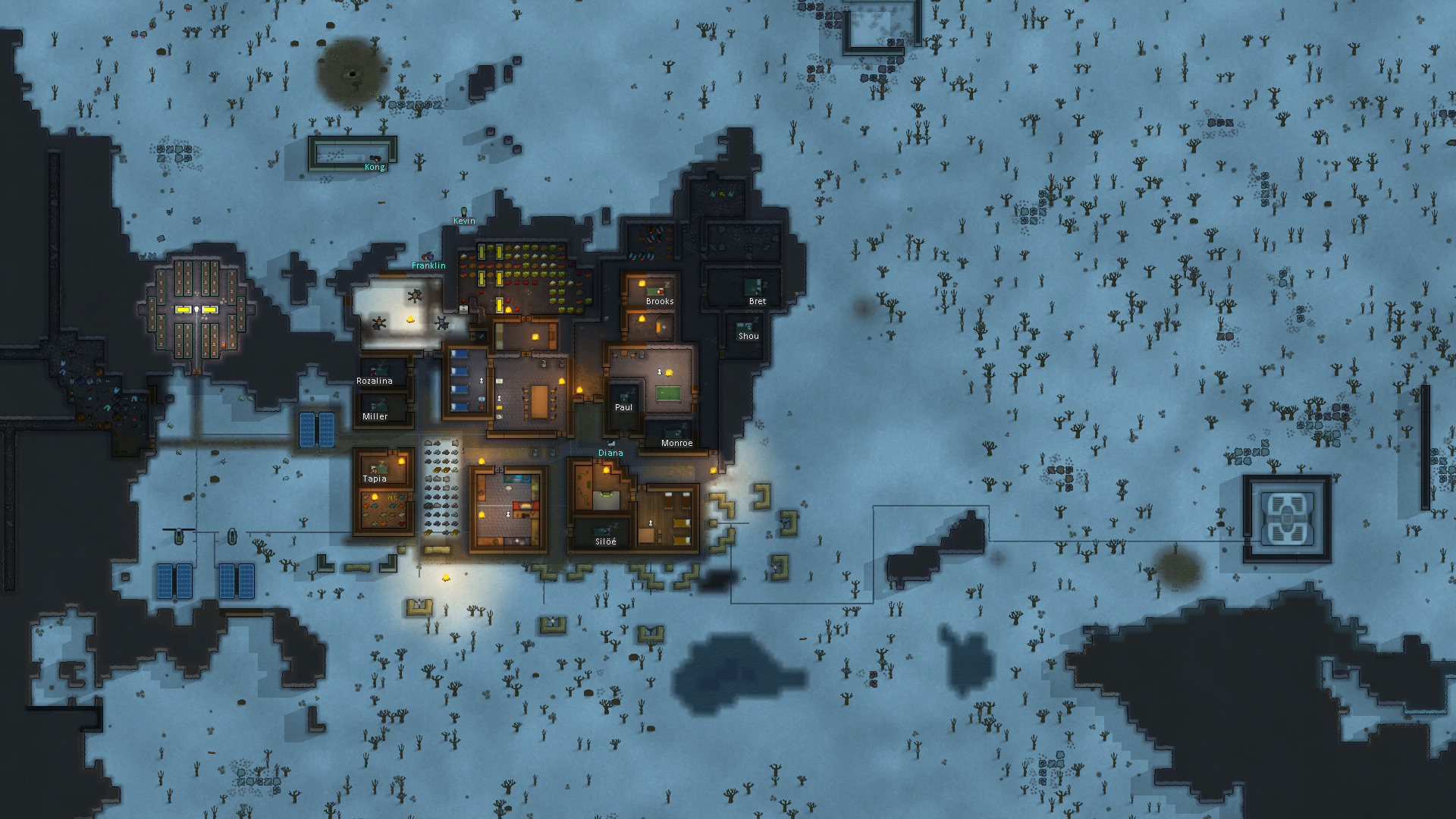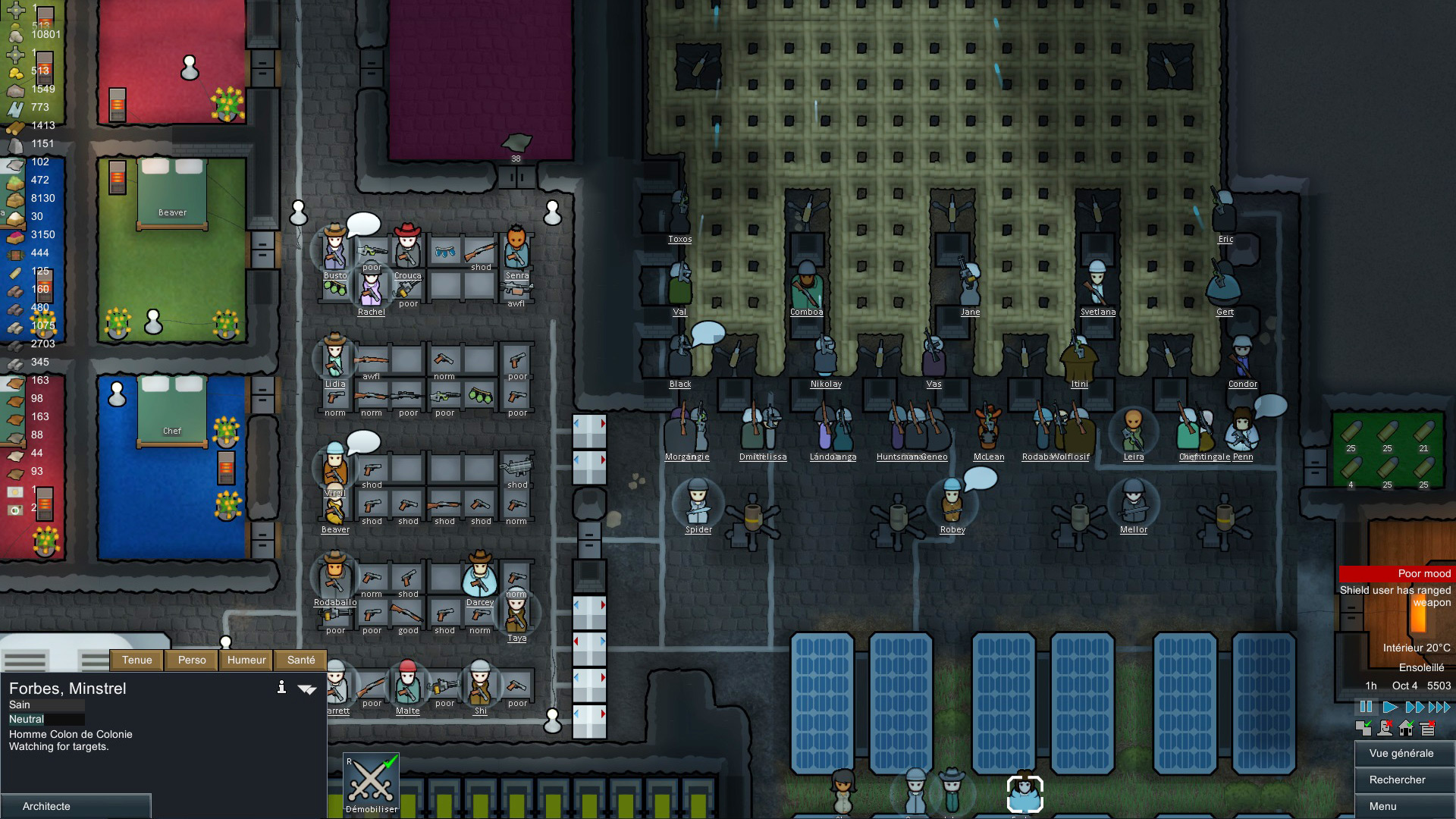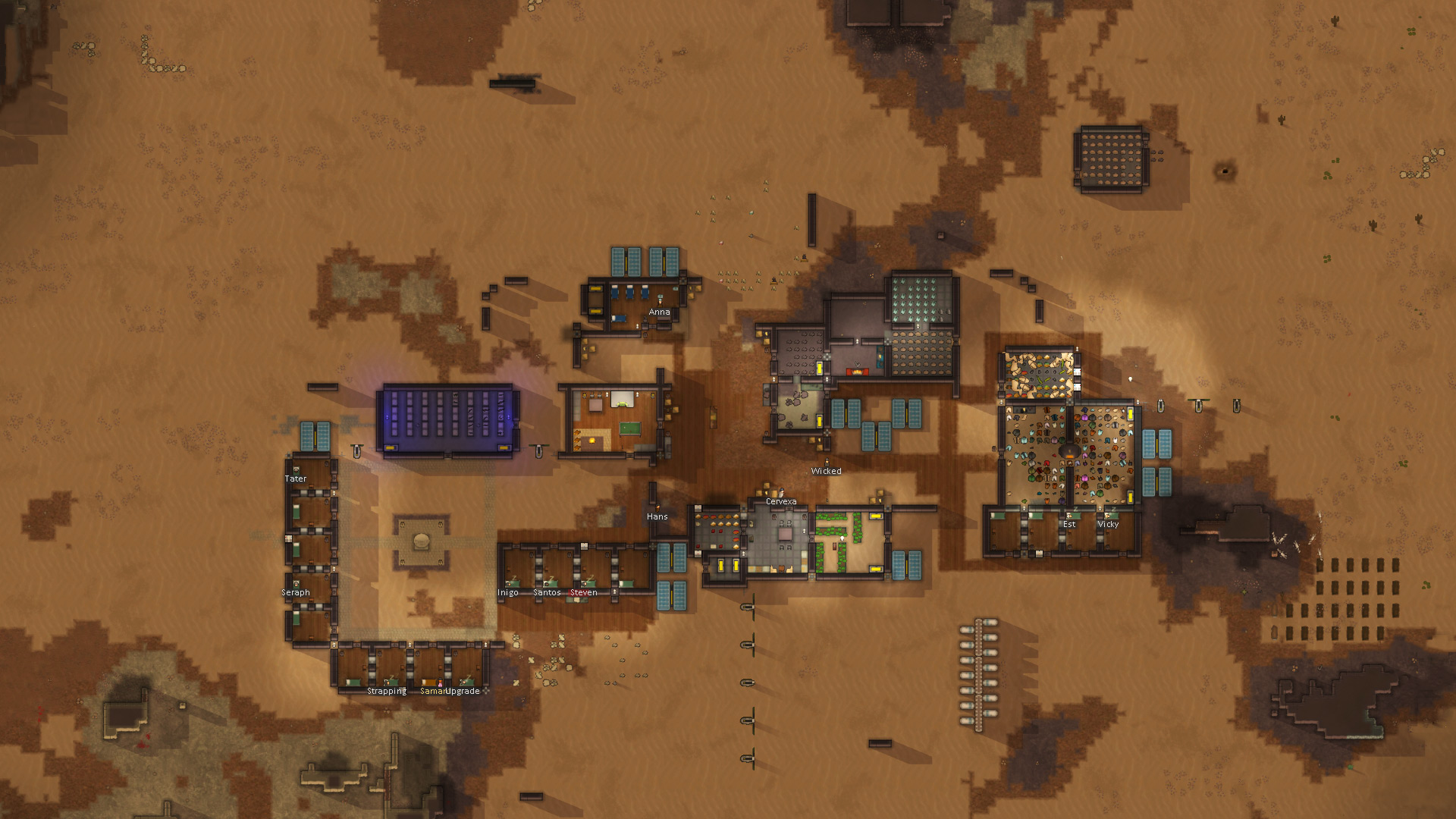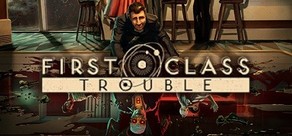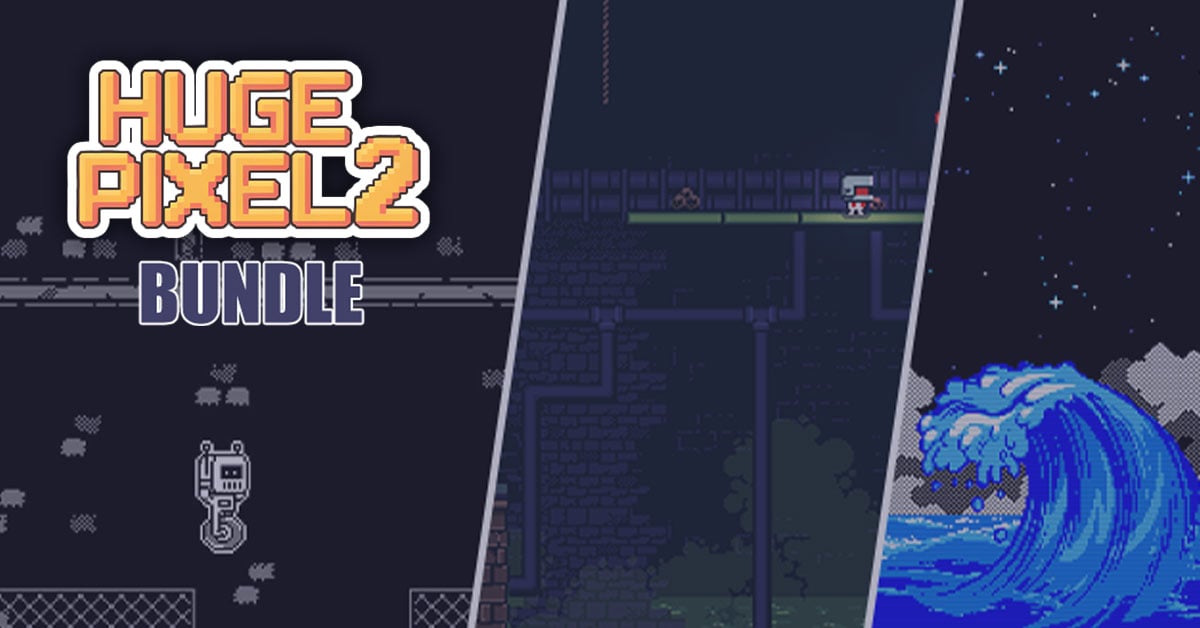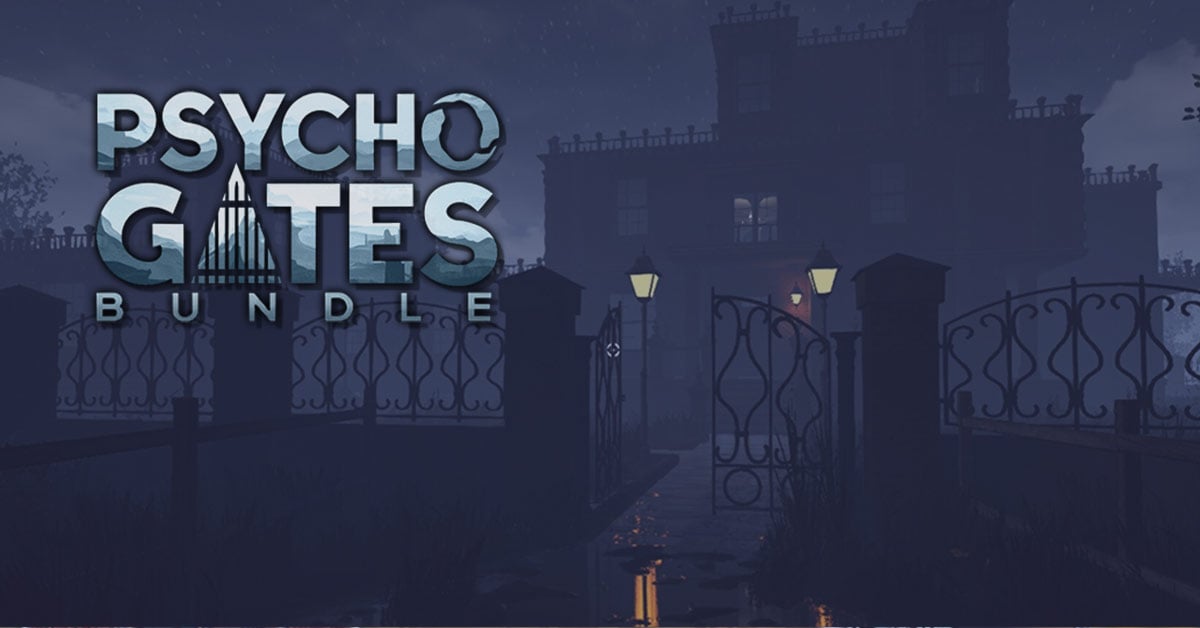RimWorld is a sci-fi colony sim driven by an intelligent AI storyteller. Inspired by Dwarf Fortress, Firefly, and Dune.
You begin with three survivors of a shipwreck on a distant world.
RimWorld is a story generator. It’s designed to co-author tragic, twisted, and triumphant stories about imprisoned pirates, desperate colonists, starvation and survival. It works by controlling the “random” events that the world throws at you. Every thunderstorm, pirate raid, and traveling salesman is a card dealt into your story by the AI Storyteller. There are several storytellers to choose from. Randy Random does crazy stuff, Cassandra Classic goes for rising tension, and Phoebe Friendly just makes good things happen.
Your colonists are not professional settlers – they’re crash-landed survivors from a passenger liner destroyed in orbit. You can end up with a nobleman, an accountant, and a housewife. You’ll acquire more colonists by capturing them in combat and turning them to your side, buying them from slave traders, or taking in refugees. So your colony will always be a motley crew.
Each person’s background is tracked and affects how they play. A nobleman will be great at social skills (recruiting prisoners, negotiating trade prices), but refuse to do physical work. A farm oaf knows how to grow food by long experience, but cannot do research. A nerdy scientist is great at research, but cannot do social tasks at all. A genetically engineered assassin can do nothing but kill – but he does that very well.
Colonists develop - and destroy - relationships. Each has an opinion of the others, which determines whether they'll become lovers, marry, cheat, or fight. Perhaps your two best colonists are happily married - until one of them falls for the dashing surgeon who saved her from a gunshot wound.
The game generates a whole planet from pole to equator. You choose whether to land your crash pods in a cold northern tundra, a parched desert plain, a temperate forest, or a steaming equatorial jungle. Different areas have different animals, plants, diseases, temperatures, rainfall, mineral resources, and terrain. These challenges of surviving in a disease-infested, choking jungle are very different from those in a parched desert wasteland or a frozen tundra with a two-month growing season.
You can tame and train animals. Lovable pets will cheer up sad colonists. Farm animals can be worked, milked, and sheared. Attack beasts can be released upon your enemies. There are many animals - cats, labrador retrievers, grizzly bears, camels, cougars, chinchillas, chickens, and exotic alien-like lifeforms.
People in RimWorld constantly observe their situation and surroundings in order to decide how to feel at any given moment. They respond to hunger and fatigue, witnessing death, disrespectfully unburied corpses, being wounded, being left in darkness, getting packed into cramped environments, sleeping outside or in the same room as others, and many other situations. If they're too stressed, they might lash out or break down.
Wounds, infections, prosthetics, and chronic conditions are tracked on each body part and affect characters' capacities. Eye injuries make it hard to shoot or do surgery. Wounded legs slow people down. Hands, brain, mouth, heart, liver, kidneys, stomach, feet, fingers, toes, and more can all be wounded, diseased, or missing, and all have logical in-game effects. And other species have their own body layouts - take off a deer's leg, and it can still hobble on the other three. Take off a rhino's horn, and it's much less dangerous.
You can repair body parts with prosthetics ranging from primitive to transcendent. A peg leg will get Joe Colonist walking after an unfortunate incident with a rhinoceros, but he'll still be quite slow. Buy an expensive bionic leg from a trader the next year, and Joe becomes a superhuman runner. You can even extract, sell, buy, and transplant internal organs.
And there's much more than that! The game is easy to mod and has an active mod community. Read more at http://rimworldgame.com.
(All non-English translations are made by fans.)
You begin with three survivors of a shipwreck on a distant world.
- Manage colonists' moods, needs, wounds, and illnesses.
- Fashion structures, weapons, and apparel from metal, wood, stone, cloth, or futuristic materials.
- Tame and train cute pets, productive farm animals, and deadly attack beasts.
- Watch colonists develop and break relationships with family members, lovers, and spouses.
- Fight pirate raiders, hostile tribes, rampaging animals, giant tunnelling insects and ancient killing machines.
- Trade with passing ships and trade caravans.
- Decorate your colony to make it into a pleasurable space.
- Dig through snow, weather storms, and fight fires.
- Capture refugees or prisoners and turn them to your side or sell them into slavery.
- Discover a new generated world each time you play.
- Build colonies in the desert, jungle, tundra, and more.
- Learn to play easily with the help of an intelligent and unobtrusive AI tutor.
RimWorld is a story generator. It’s designed to co-author tragic, twisted, and triumphant stories about imprisoned pirates, desperate colonists, starvation and survival. It works by controlling the “random” events that the world throws at you. Every thunderstorm, pirate raid, and traveling salesman is a card dealt into your story by the AI Storyteller. There are several storytellers to choose from. Randy Random does crazy stuff, Cassandra Classic goes for rising tension, and Phoebe Friendly just makes good things happen.
Your colonists are not professional settlers – they’re crash-landed survivors from a passenger liner destroyed in orbit. You can end up with a nobleman, an accountant, and a housewife. You’ll acquire more colonists by capturing them in combat and turning them to your side, buying them from slave traders, or taking in refugees. So your colony will always be a motley crew.
Each person’s background is tracked and affects how they play. A nobleman will be great at social skills (recruiting prisoners, negotiating trade prices), but refuse to do physical work. A farm oaf knows how to grow food by long experience, but cannot do research. A nerdy scientist is great at research, but cannot do social tasks at all. A genetically engineered assassin can do nothing but kill – but he does that very well.
Colonists develop - and destroy - relationships. Each has an opinion of the others, which determines whether they'll become lovers, marry, cheat, or fight. Perhaps your two best colonists are happily married - until one of them falls for the dashing surgeon who saved her from a gunshot wound.
The game generates a whole planet from pole to equator. You choose whether to land your crash pods in a cold northern tundra, a parched desert plain, a temperate forest, or a steaming equatorial jungle. Different areas have different animals, plants, diseases, temperatures, rainfall, mineral resources, and terrain. These challenges of surviving in a disease-infested, choking jungle are very different from those in a parched desert wasteland or a frozen tundra with a two-month growing season.
You can tame and train animals. Lovable pets will cheer up sad colonists. Farm animals can be worked, milked, and sheared. Attack beasts can be released upon your enemies. There are many animals - cats, labrador retrievers, grizzly bears, camels, cougars, chinchillas, chickens, and exotic alien-like lifeforms.
People in RimWorld constantly observe their situation and surroundings in order to decide how to feel at any given moment. They respond to hunger and fatigue, witnessing death, disrespectfully unburied corpses, being wounded, being left in darkness, getting packed into cramped environments, sleeping outside or in the same room as others, and many other situations. If they're too stressed, they might lash out or break down.
Wounds, infections, prosthetics, and chronic conditions are tracked on each body part and affect characters' capacities. Eye injuries make it hard to shoot or do surgery. Wounded legs slow people down. Hands, brain, mouth, heart, liver, kidneys, stomach, feet, fingers, toes, and more can all be wounded, diseased, or missing, and all have logical in-game effects. And other species have their own body layouts - take off a deer's leg, and it can still hobble on the other three. Take off a rhino's horn, and it's much less dangerous.
You can repair body parts with prosthetics ranging from primitive to transcendent. A peg leg will get Joe Colonist walking after an unfortunate incident with a rhinoceros, but he'll still be quite slow. Buy an expensive bionic leg from a trader the next year, and Joe becomes a superhuman runner. You can even extract, sell, buy, and transplant internal organs.
And there's much more than that! The game is easy to mod and has an active mod community. Read more at http://rimworldgame.com.
(All non-English translations are made by fans.)
Biotech preview #4: Xenotypes, world factions, and the dark blood-drinkers
If you intend to stay on version 1.3 after Friday (for mod compatibility or for any other reason), please switch your Steam beta branch to version-1.3.
Now, lets talk about Biotechs new xenohumans!
As youve seen before , Biotech lets you create your own kinds of xenohumans by mixing and matching from over 200 different genes. But this isnt just a player tool - xenohumans are part of the universe of RimWorld. Whereas RimWorlds base game has all human factions, with Biotech, youll interact with a variety of xenohumans and their new factions.
We designed the xenohuman types to emerge naturally from RimWorlds fictional universe, play distinctly from each other, and enrich the game as foes, prisoners, gene farms, allies, and colonists.
Embedding xenohumans into the world helps the game in a lot of ways. It lets players experience the new gene-linked abilities both as player tools and as enemy threats. NPC xenohumans are a way for you to access many genes by capturing a foe and placing them in a gene extractor. Seeing other xenohumans helps show the player the kinds of things that are possible with their own genetic experiments. Also, the xenohuman types work as a scaffolding for more content, like the sanguophages special secret quests (more on that later).
Fundamentally, xenohumans make the human world more diverse. Factions feel more different when they have different combat abilities and physical characteristics. The recruits you get from different places will have more exotic abilities. Characters are more distinct from each other in gameplay mechanics and style. Handling a group of frenzied fire-breathers launching burning arrows is different from stopping the wolf escorts sent by furry yttakin riflemen. Fighting neanderthals is a slugfest; fighting wasters is a chokehold; fighting impids is a flame war.
Writing the name generators for each xenotype culture was also a ton of fun.
Lets look at the xenotypes in Biotech:

Pigskins are human-pig hybrids which are capable of two-legged movement, tool use, and speech, but which also retain many pig-like qualities. They are hardy and can eat almost anything without getting sick, but their trotter-shaped hands leave them at a disadvantage when attempting to precisely manipulate tools and objects. They don't see well at a distance, so pigskin gangs usually focus on close-range weapons. They also have a strong taste for explosives.
Pigskins were made for their organs. Uncomfortable with the idea of harvesting organs from baseliner humans, a long-gone government merged human DNA into pigs to make the animals produce more easily-transplantable hearts and livers. They succeeded, but the resulting creatures became more humanlike than anyone anticipated.
The pigskins faction is the rough pig union, a loose union of hardy pigskin townships. They're willing to make friends, even with thinsnouts, but they're also ready to toss a bomb and gnaw human gristle when it suits them. Treat them with respect and they'll offer a trotter to an ally in need. Turn against them and the last thing you hear might be a triumphant battle squeal.
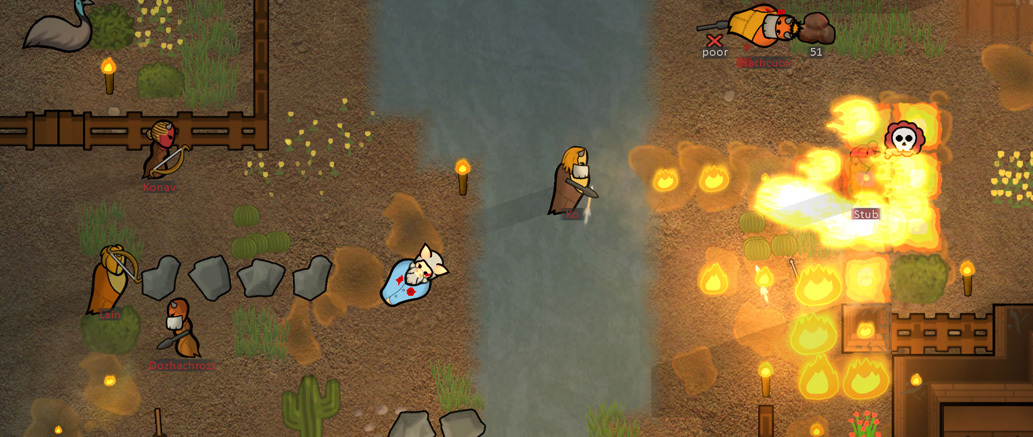
Made for desert life, impid cultures live on many rimworlds and dry deathworlds. Impids are extremely fast-moving, easily tolerate high temperatures, and can spew fire from their mouths. Though they are masters on the sand, impids struggle in other environments. They are terrible with farming. They fight well at range, but in close combat their physical weakness becomes apparent.
Outlanders call them dustrunners because of their speed over open terrain and resistance to heat. Some tribes call them devils because of their horns and because they burn their enemies.
The savage impid tribe has no intention of coexisting peacefully with anyone else. Their warriors are experts at using their natural speed and flame attacks to burn the towns and children of other peoples. Impid tribes' combat tactics usually center on rapid-approach incendiary attacks using both handheld fire weapons and their fire spew ability.
Having been on the planet for thousands of years, the origins of this tribe are lost in myth. They might descend from a group of settlers who lost their technology, or an impid community in some long-ruined civilization.

Yttakin (pronounced roughly as ee-ta-keen) descend from colonists engineered to thrive on ultra-cold planets. Their great size and fur make them hardy in frozen environments. Yttakin share a psychic connection with the wildlife and can summon animals to their side during battles. They are not fast or energetic or precise, but can keep going when others would have collapsed long before.
Since they migrated off their icy birthworld of Yttak, Yttakin settlements live on many planets. Their fur, roaring voices, and aversion to urban living sometimes leads naive outsiders to believe they are simple-minded animals. Quick-minded Yttakin are happy to make good use of such wrong beliefs, whether at the negotiating table or on the battlefield.
The faction of yttakin pirates choose to be isolated, and they refuse to deal with outsiders. Theyre quick to call animal warriors against anyone who threatens or disrespects them. Underestimating their wild animal companions would be a mistake. However, a captured and recruited yttakin can be a strong ally.

Neanderthals are stocky, powerfully-built humanoids. Their most salient characteristic is that they are difficult to hurt: they are very resistant to injury, and their strong immune systems protect them from infection. However, without ever having evolved in a complex civilization, they are less adept than baseliner humans at intellectual and social tasks, and their impulsiveness can make them dangerously aggressive.
Homo neanderthalensis was originally an archaic population of hominids that emerged over 200,000 years ago during the Pleistocene epoch. After they were replaced by and merged with humans 30,000 years ago, they were absent for tens of thousands of years until scientists resurrected them from ancient DNA. Neanderthals now survive in sub-societies on some settled planets. On the rimworlds, neanderthal tribes carve out the same existence as their Earth ancestors did so long ago.
The fierce neanderthal tribe lives in the deep wilderness. They are open to peaceful trade, but are otherwise unfriendly and territorial. Warriors from their tribe wont hesitate to bash in the skulls of anyone they deem dangerous. Their numbers, and the extreme amounts of damage they absorb before falling make them serious foes despite their lack of technology and analytical ability.
Having been on this planet for countless generations, they have no memory of how they got here. They might be the descendants of a neanderthal service caste from a dead civilization, or even the leftovers from some ancient science experiment.

With gray skin adapted to artificial light, dirtmoles thrive in cramped and dark spaces where combat and travel happen over short distances. They are extremely capable at digging or mining tasks. In the open, however, they suffer from a sensitivity to light, slow speed and poor eyesight at distance.
After the first tunnel colonies failed due to the stress of confinement, colonization agencies began genetically altering colonists to live without open space or sunlight. This xenotype are known colloquially as dirtmoles. Today, dirtmoles have expanded out of their original tunnel homes and rule many confined spaces in the anthrosphere. They can be found in deep mines, cramped low-tech spacecraft, and teeming by the billions in the dark underlayers of countless urbworlds.
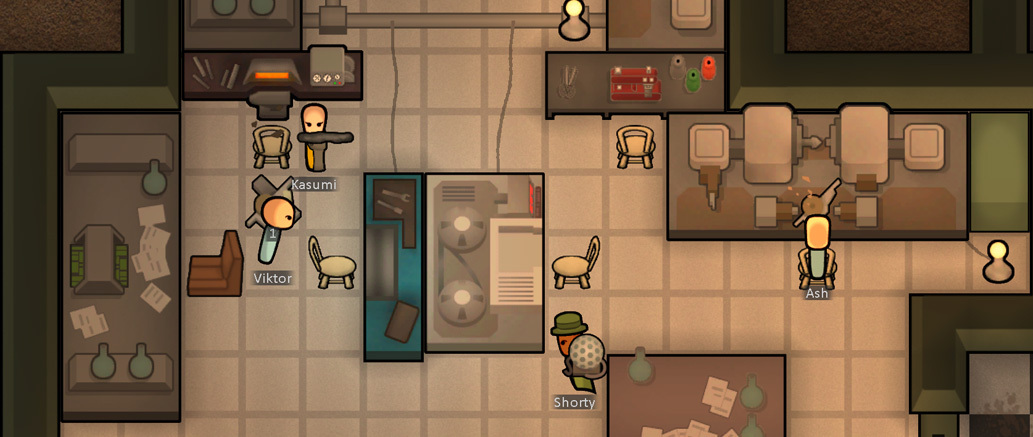
Designed to be engineers, genies' delicate bones and natural aptitude with machines allow them to manipulate devices with remarkable precision. They are emotionally cold and can follow orders where others might panic. However, they are fragile, and their amplified nerve impulses make them easy to debilitate with relatively little pain. With so much of their brains dedicated to analyzing machines, they lack the neural hardware to analyze emotions, so they sometimes come off as socially inept. Their dead calm makes it even harder for them to relate to what they see as madly-hotheaded baseliner humans.
Genies were engineered thousands of years ago by a long-disbanded space navy to hold engineering positions on large starships. Today, genies still serve as engineers in great cities and fleets, but many can also be found working as lawyers, pilots, and musicians.
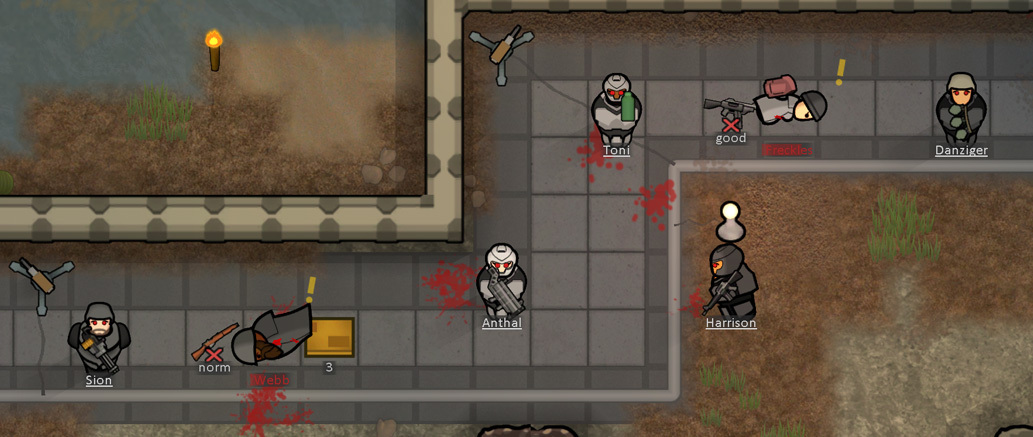
Hussars are engineered soldiers. They fight aggressively and with precision, heal fast, thrive in extreme temperatures, and freely ingest military drugs. They have a genetic dependence on the drug go-juice, which also makes them less likely to rebel against their commanders.
While hussars' emotions make them dangerous in combat, they can't relate to baseliner humans. They are famous for their blood-red eyes and "hussar stare", a dead expression that unsettles many people.
Their lack of expression and burning aggressive nature has led to many violent misunderstandings.
In most societies where they live, hussars are kept separated from the rest of the population. Hussars are single-purpose tools - and they generally aren't bothered by the fact.

Empathic and effortlessly beautiful, these designed companions and concubines have the unique ability to psychically bond with a mate. In a certain context, they seem to be perfect - happy, charming, and kind. However, they are also inept at manual tasks, physically weak, and mentally incapable of violence even if their life depends on it.
On a few wealthy worlds, highmate xenogerms are commercially available and some people become highmates as a sort of career. However, many societies find them abhorrent, either because they distract people from forming natural families, or because they are humans shaped to serve the pleasures of another. On such worlds they are either reserved as playthings of the powerful, or banned entirely. This particular line of highmate fits the fashions of classical Novaroma, but many other variants exist.

Wasters are gaunt-faced, grey-skinned, aggressive, immune to toxic pollution, almost impervious to disease, and can ingest as much psychite and wake-up drugs as they wish with no ill effects. Their toxin-adapted metabolism means they must consume some form of psychite to survive - usually flake or yayo.
Originally engineered to prevent resettlement of post-apocalyptic deathworlds, wasters are living area-denial weapons. Waster pirates armed with toxic weapons are the bane of many frontier peoples, both on the rimworlds and in the depths of the urbworld hyperstructures.
The faction of waster pirates are a diverse collection of violent xenohumans. They are mostly wasters, with a smattering of hussars, neanderthals, genies, dirtmoles, genies, yttakins, and pigskins. They have little interest in building, or farming, preferring to take their sustenance from others using violence. Their technology level depends mostly on who they've managed to steal from recently. Mostly they carry gunpowder weapons, though some prefer to stab victims at close range. Theyll always be a threat.
Sanguophages pass among other xenotypes undetected while concealing superhuman powers and working to satiate their genetic need for human blood. They are subjects of wild stories and childrens nightmares, and their very existence is debated. They do not reveal themselves without good reason.
Powered by archites, unique micro-machines created by archotech superintelligence, sanguophages abilities go far beyond normal genetic enhancements. They are mentally adept across domains and preternaturally beautiful. In combat, they can launch deadly spines and heal injured friends. They don't age or die naturally and never suffer from disease or poison. A sanguophage can make a new sanguophage by reimplanting their own xenogerm into a person.
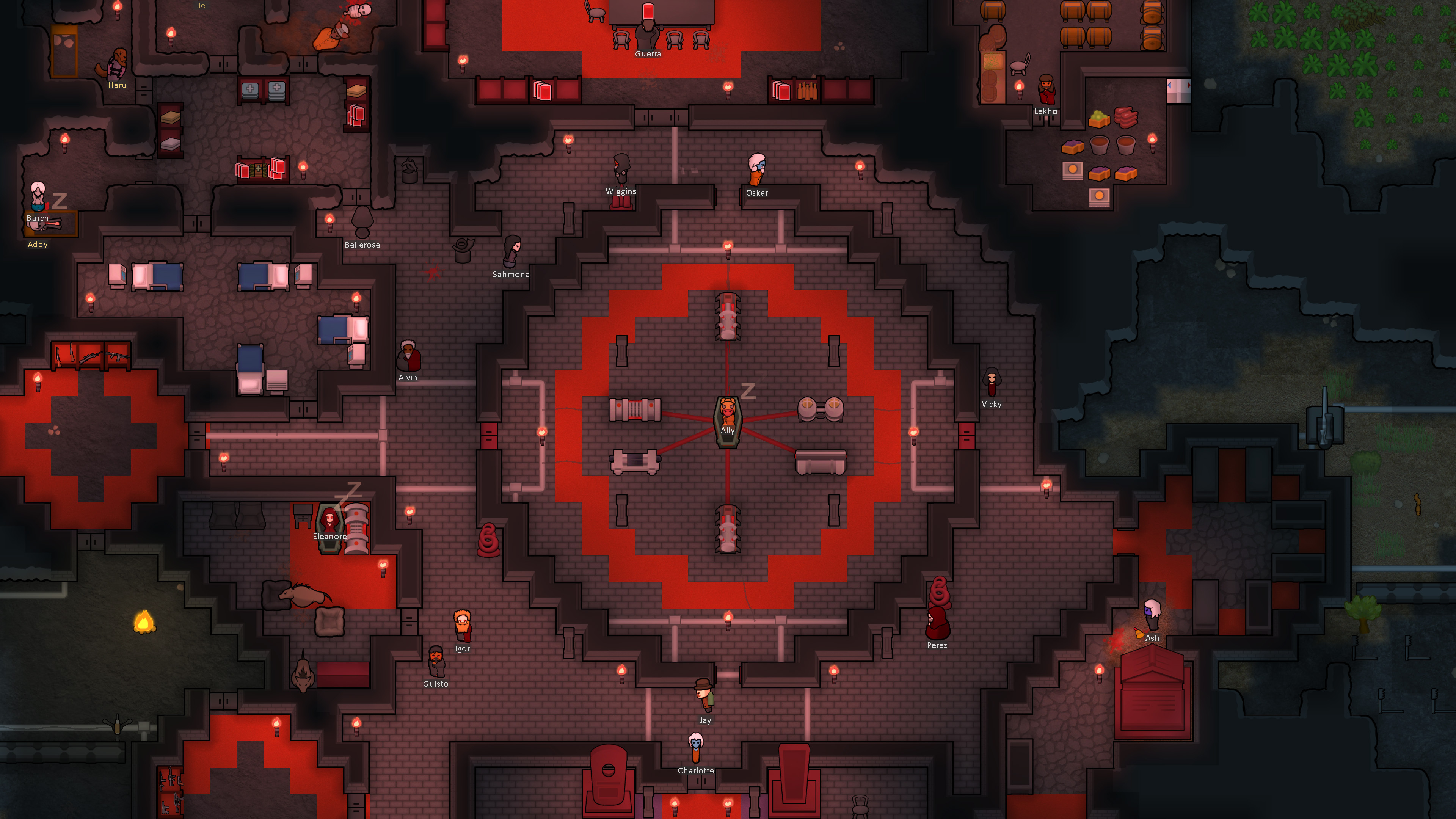
The price of all this is the endless red thirst. Sanguophages must regularly consume hemogen derived from human blood. Hemogen acts as a sort of fuel for the sanguophages powers. They're easily destroyed by fire, and slowed down by UV light.
Sanguophages must also go into deathrest every now and then, where they enter a dormant state for several days in the darkness to regenerate their powers. This process of deathrest can be enhanced by a variety of technological structures, chief among them is the deathrest casket.
The deathrest casket is an enclosed med-casket that accelerates the process of deathrest. It can connect to other devices which confer additional bonuses on the deathrester. The number of devices that can connect depends on the person's deathrest capacity, which can be seen by selecting them. The devices to connect are:
[i]The first sanguophage appeared thousands of years ago when the lord-explorer Varan-Dur sought to control a hyperintelligent archotech and found himself transformed by it instead. Every sanguophage is descended from him. Since then, sanguophages have often been hunted because of their destabilizing power and their need for blood. Since they can pass for baseliners, many live in hiding among typical humans.
Their numbers are unknown. Some think they are legends or rare irrelevancies. Some believe sanguophages secretly direct entire human civilizations. The stories speak of eternal lords ruling billions from slate-black space stations, or directing blood sacrifices at conferences in the underlayers of the deepest urbworlds.[/i]
If you want to engineer your own xenotype with sanguophage-like powers, you can find copies of the sanguophages' special superhuman genes via quests and trade. However, many of them require a unique resource called archites to be reinstalled in a new person. Archites are rare, but can be found via quests, trade, and other special means.
It is possible to be a sanguophage and another xenotype at the same time - pigskin sanguophages look pretty great in their dark hooded robes.
You can start the game as a sanguophage with a single human servant, if you want to build your own blood-harvest empire from scratch.
We made sure to design all the character-oriented enhancements so they can be used freely in any combination. We are very much looking forward to the stories of people making their favorite colonist into a royal, a psycaster, a priest, a mechanitor, a unique xenotype, and a sanguophage all at once.
Some companies have a cost first model where they decide up front to make an expansion in a fixed time/price (e.g. 6 months/$20) and force the creative process to live in those constraints. We take ideas and build them until they feel well-rounded and complete. We believe that different ideas naturally take different amounts of resources to explore, so it must be okay for different expansions to have different prices, for the same reason different games have different prices. Forcing every expansion to have the same price would mean trying to squeeze or stretch every idea into the same amount of production resources, which is not a path to creative flourishing. Thats why our expansions arent all priced the same - because theyre different in scope, because thats what the ideas wanted.
Please wishlist Biotech on Steam and share the exciting news with your pals. We seriously cannot thank the community enough for all of your passion and support (and the awesome fan art).
Also chat about the discussion of this post on Reddit!
Thanks for joining us on this journey.
- Tynan
Its Tynan here, bringing you our final Biotech preview covering the xenohumans who inhabit the world, their factions, and the mysterious blood-drinking sanguophages, and Biotechs price and release day.
Just a reminder that Biotech releases this week on Friday, October 21, 2022! Wishlist it now to get a reminder when its out!
Read the previous previews posts for Biotech:
- Biotech expansion announced: Why we made it
- Biotech preview #1: Mechanitor infrastructure and labor mechs
- Biotech preview #2: Combat mechanoids, pollution, and super-mechanoid bosses
- Biotech preview #3: Reproduction, children, genetic modification
- [Here] Biotech preview #4: Xenotypes, world factions, and the dark blood-drinkers
If you intend to stay on version 1.3 after Friday (for mod compatibility or for any other reason), please switch your Steam beta branch to version-1.3.
Now, lets talk about Biotechs new xenohumans!
Xenohumans in the world
As youve seen before , Biotech lets you create your own kinds of xenohumans by mixing and matching from over 200 different genes. But this isnt just a player tool - xenohumans are part of the universe of RimWorld. Whereas RimWorlds base game has all human factions, with Biotech, youll interact with a variety of xenohumans and their new factions.
We designed the xenohuman types to emerge naturally from RimWorlds fictional universe, play distinctly from each other, and enrich the game as foes, prisoners, gene farms, allies, and colonists.
Embedding xenohumans into the world helps the game in a lot of ways. It lets players experience the new gene-linked abilities both as player tools and as enemy threats. NPC xenohumans are a way for you to access many genes by capturing a foe and placing them in a gene extractor. Seeing other xenohumans helps show the player the kinds of things that are possible with their own genetic experiments. Also, the xenohuman types work as a scaffolding for more content, like the sanguophages special secret quests (more on that later).
Fundamentally, xenohumans make the human world more diverse. Factions feel more different when they have different combat abilities and physical characteristics. The recruits you get from different places will have more exotic abilities. Characters are more distinct from each other in gameplay mechanics and style. Handling a group of frenzied fire-breathers launching burning arrows is different from stopping the wolf escorts sent by furry yttakin riflemen. Fighting neanderthals is a slugfest; fighting wasters is a chokehold; fighting impids is a flame war.
Writing the name generators for each xenotype culture was also a ton of fun.
Lets look at the xenotypes in Biotech:
Pigskins

Pigskins are human-pig hybrids which are capable of two-legged movement, tool use, and speech, but which also retain many pig-like qualities. They are hardy and can eat almost anything without getting sick, but their trotter-shaped hands leave them at a disadvantage when attempting to precisely manipulate tools and objects. They don't see well at a distance, so pigskin gangs usually focus on close-range weapons. They also have a strong taste for explosives.
Pigskins were made for their organs. Uncomfortable with the idea of harvesting organs from baseliner humans, a long-gone government merged human DNA into pigs to make the animals produce more easily-transplantable hearts and livers. They succeeded, but the resulting creatures became more humanlike than anyone anticipated.
The pigskins faction is the rough pig union, a loose union of hardy pigskin townships. They're willing to make friends, even with thinsnouts, but they're also ready to toss a bomb and gnaw human gristle when it suits them. Treat them with respect and they'll offer a trotter to an ally in need. Turn against them and the last thing you hear might be a triumphant battle squeal.
Impids

Made for desert life, impid cultures live on many rimworlds and dry deathworlds. Impids are extremely fast-moving, easily tolerate high temperatures, and can spew fire from their mouths. Though they are masters on the sand, impids struggle in other environments. They are terrible with farming. They fight well at range, but in close combat their physical weakness becomes apparent.
Outlanders call them dustrunners because of their speed over open terrain and resistance to heat. Some tribes call them devils because of their horns and because they burn their enemies.
The savage impid tribe has no intention of coexisting peacefully with anyone else. Their warriors are experts at using their natural speed and flame attacks to burn the towns and children of other peoples. Impid tribes' combat tactics usually center on rapid-approach incendiary attacks using both handheld fire weapons and their fire spew ability.
Having been on the planet for thousands of years, the origins of this tribe are lost in myth. They might descend from a group of settlers who lost their technology, or an impid community in some long-ruined civilization.
Yttakin

Yttakin (pronounced roughly as ee-ta-keen) descend from colonists engineered to thrive on ultra-cold planets. Their great size and fur make them hardy in frozen environments. Yttakin share a psychic connection with the wildlife and can summon animals to their side during battles. They are not fast or energetic or precise, but can keep going when others would have collapsed long before.
Since they migrated off their icy birthworld of Yttak, Yttakin settlements live on many planets. Their fur, roaring voices, and aversion to urban living sometimes leads naive outsiders to believe they are simple-minded animals. Quick-minded Yttakin are happy to make good use of such wrong beliefs, whether at the negotiating table or on the battlefield.
The faction of yttakin pirates choose to be isolated, and they refuse to deal with outsiders. Theyre quick to call animal warriors against anyone who threatens or disrespects them. Underestimating their wild animal companions would be a mistake. However, a captured and recruited yttakin can be a strong ally.
Neanderthals

Neanderthals are stocky, powerfully-built humanoids. Their most salient characteristic is that they are difficult to hurt: they are very resistant to injury, and their strong immune systems protect them from infection. However, without ever having evolved in a complex civilization, they are less adept than baseliner humans at intellectual and social tasks, and their impulsiveness can make them dangerously aggressive.
Homo neanderthalensis was originally an archaic population of hominids that emerged over 200,000 years ago during the Pleistocene epoch. After they were replaced by and merged with humans 30,000 years ago, they were absent for tens of thousands of years until scientists resurrected them from ancient DNA. Neanderthals now survive in sub-societies on some settled planets. On the rimworlds, neanderthal tribes carve out the same existence as their Earth ancestors did so long ago.
The fierce neanderthal tribe lives in the deep wilderness. They are open to peaceful trade, but are otherwise unfriendly and territorial. Warriors from their tribe wont hesitate to bash in the skulls of anyone they deem dangerous. Their numbers, and the extreme amounts of damage they absorb before falling make them serious foes despite their lack of technology and analytical ability.
Having been on this planet for countless generations, they have no memory of how they got here. They might be the descendants of a neanderthal service caste from a dead civilization, or even the leftovers from some ancient science experiment.
Dirtmoles

With gray skin adapted to artificial light, dirtmoles thrive in cramped and dark spaces where combat and travel happen over short distances. They are extremely capable at digging or mining tasks. In the open, however, they suffer from a sensitivity to light, slow speed and poor eyesight at distance.
After the first tunnel colonies failed due to the stress of confinement, colonization agencies began genetically altering colonists to live without open space or sunlight. This xenotype are known colloquially as dirtmoles. Today, dirtmoles have expanded out of their original tunnel homes and rule many confined spaces in the anthrosphere. They can be found in deep mines, cramped low-tech spacecraft, and teeming by the billions in the dark underlayers of countless urbworlds.
Genies

Designed to be engineers, genies' delicate bones and natural aptitude with machines allow them to manipulate devices with remarkable precision. They are emotionally cold and can follow orders where others might panic. However, they are fragile, and their amplified nerve impulses make them easy to debilitate with relatively little pain. With so much of their brains dedicated to analyzing machines, they lack the neural hardware to analyze emotions, so they sometimes come off as socially inept. Their dead calm makes it even harder for them to relate to what they see as madly-hotheaded baseliner humans.
Genies were engineered thousands of years ago by a long-disbanded space navy to hold engineering positions on large starships. Today, genies still serve as engineers in great cities and fleets, but many can also be found working as lawyers, pilots, and musicians.
Hussars

Hussars are engineered soldiers. They fight aggressively and with precision, heal fast, thrive in extreme temperatures, and freely ingest military drugs. They have a genetic dependence on the drug go-juice, which also makes them less likely to rebel against their commanders.
While hussars' emotions make them dangerous in combat, they can't relate to baseliner humans. They are famous for their blood-red eyes and "hussar stare", a dead expression that unsettles many people.
Their lack of expression and burning aggressive nature has led to many violent misunderstandings.
In most societies where they live, hussars are kept separated from the rest of the population. Hussars are single-purpose tools - and they generally aren't bothered by the fact.
Highmates

Empathic and effortlessly beautiful, these designed companions and concubines have the unique ability to psychically bond with a mate. In a certain context, they seem to be perfect - happy, charming, and kind. However, they are also inept at manual tasks, physically weak, and mentally incapable of violence even if their life depends on it.
On a few wealthy worlds, highmate xenogerms are commercially available and some people become highmates as a sort of career. However, many societies find them abhorrent, either because they distract people from forming natural families, or because they are humans shaped to serve the pleasures of another. On such worlds they are either reserved as playthings of the powerful, or banned entirely. This particular line of highmate fits the fashions of classical Novaroma, but many other variants exist.
Wasters

Wasters are gaunt-faced, grey-skinned, aggressive, immune to toxic pollution, almost impervious to disease, and can ingest as much psychite and wake-up drugs as they wish with no ill effects. Their toxin-adapted metabolism means they must consume some form of psychite to survive - usually flake or yayo.
Originally engineered to prevent resettlement of post-apocalyptic deathworlds, wasters are living area-denial weapons. Waster pirates armed with toxic weapons are the bane of many frontier peoples, both on the rimworlds and in the depths of the urbworld hyperstructures.
The faction of waster pirates are a diverse collection of violent xenohumans. They are mostly wasters, with a smattering of hussars, neanderthals, genies, dirtmoles, genies, yttakins, and pigskins. They have little interest in building, or farming, preferring to take their sustenance from others using violence. Their technology level depends mostly on who they've managed to steal from recently. Mostly they carry gunpowder weapons, though some prefer to stab victims at close range. Theyll always be a threat.
Sanguophages
Minor spoilers in this section - skip if you want the purest play experience!Sanguophages pass among other xenotypes undetected while concealing superhuman powers and working to satiate their genetic need for human blood. They are subjects of wild stories and childrens nightmares, and their very existence is debated. They do not reveal themselves without good reason.
Powered by archites, unique micro-machines created by archotech superintelligence, sanguophages abilities go far beyond normal genetic enhancements. They are mentally adept across domains and preternaturally beautiful. In combat, they can launch deadly spines and heal injured friends. They don't age or die naturally and never suffer from disease or poison. A sanguophage can make a new sanguophage by reimplanting their own xenogerm into a person.

The price of all this is the endless red thirst. Sanguophages must regularly consume hemogen derived from human blood. Hemogen acts as a sort of fuel for the sanguophages powers. They're easily destroyed by fire, and slowed down by UV light.
Sanguophages must also go into deathrest every now and then, where they enter a dormant state for several days in the darkness to regenerate their powers. This process of deathrest can be enhanced by a variety of technological structures, chief among them is the deathrest casket.
The deathrest casket is an enclosed med-casket that accelerates the process of deathrest. It can connect to other devices which confer additional bonuses on the deathrester. The number of devices that can connect depends on the person's deathrest capacity, which can be seen by selecting them. The devices to connect are:
- Hemopump: This blood-refining pump increases the amount of hemogen a deathresting person can store in their body.
- Hemogen amplifier: This device leaves a deathrester in a hemogen-amplified state so they gain more hemogen from any hemogen source. Using a gland probe and blood analyzer, it links with a deathresting person, stimulating hemogen glands into a more active state.
- Glucosoid pump: This device allows a deathrester to move faster after deathrest is complete. It pumps the body with extra muscle-signaling factors while cleaning waste products from muscle tissue.
- Psychofluoid pump: This device enhances the psychic sensitivity of a deathresting person by rhythmically stimulating neural tissues.
- Deathrest accelerator: This device connects with a deathresting person and makes deathrest complete quicker. It enhances the effect of the deathrest casket using finer blood analysis and more powerful chemicals.
[i]The first sanguophage appeared thousands of years ago when the lord-explorer Varan-Dur sought to control a hyperintelligent archotech and found himself transformed by it instead. Every sanguophage is descended from him. Since then, sanguophages have often been hunted because of their destabilizing power and their need for blood. Since they can pass for baseliners, many live in hiding among typical humans.
Their numbers are unknown. Some think they are legends or rare irrelevancies. Some believe sanguophages secretly direct entire human civilizations. The stories speak of eternal lords ruling billions from slate-black space stations, or directing blood sacrifices at conferences in the underlayers of the deepest urbworlds.[/i]
If you want to engineer your own xenotype with sanguophage-like powers, you can find copies of the sanguophages' special superhuman genes via quests and trade. However, many of them require a unique resource called archites to be reinstalled in a new person. Archites are rare, but can be found via quests, trade, and other special means.
It is possible to be a sanguophage and another xenotype at the same time - pigskin sanguophages look pretty great in their dark hooded robes.
You can start the game as a sanguophage with a single human servant, if you want to build your own blood-harvest empire from scratch.
We made sure to design all the character-oriented enhancements so they can be used freely in any combination. We are very much looking forward to the stories of people making their favorite colonist into a royal, a psycaster, a priest, a mechanitor, a unique xenotype, and a sanguophage all at once.
Biotechs price
Biotech will be priced slightly differently from our previous expansions, at $24.99 USD. (Other territories have different prices on Steam.) We hired a lot of people and took a lot of time (15 months) to make Biotech because thats what it took to properly explore the ideas that we set out to explore. The feature set got big enough that we seriously discussed splitting this into two expansions, but decided to keep it as one.Some companies have a cost first model where they decide up front to make an expansion in a fixed time/price (e.g. 6 months/$20) and force the creative process to live in those constraints. We take ideas and build them until they feel well-rounded and complete. We believe that different ideas naturally take different amounts of resources to explore, so it must be okay for different expansions to have different prices, for the same reason different games have different prices. Forcing every expansion to have the same price would mean trying to squeeze or stretch every idea into the same amount of production resources, which is not a path to creative flourishing. Thats why our expansions arent all priced the same - because theyre different in scope, because thats what the ideas wanted.
Biotechs release day!
RimWorld - Biotech and free update 1.4 release this Friday, October 21, 2022.Please wishlist Biotech on Steam and share the exciting news with your pals. We seriously cannot thank the community enough for all of your passion and support (and the awesome fan art).
Also chat about the discussion of this post on Reddit!
Thanks for joining us on this journey.
- Tynan
[ 2022-10-18 16:04:55 CET ] [Original Post]
Minimum Setup
- Processor: Core 2 DuoMemory: 4 GB RAM
- Memory: 4 GB RAM
- Graphics: Intel HD Graphics 4000 or other shader model 4.0
- Storage: 1 GB available space
GAMEBILLET
[ 6376 ]
FANATICAL
[ 5865 ]
GAMERSGATE
[ 751 ]
MacGameStore
[ 2194 ]
FANATICAL BUNDLES
GMG BUNDLES
HUMBLE BUNDLES
INDIEGALA BUNDLES
by buying games/dlcs from affiliate links you are supporting tuxDB

